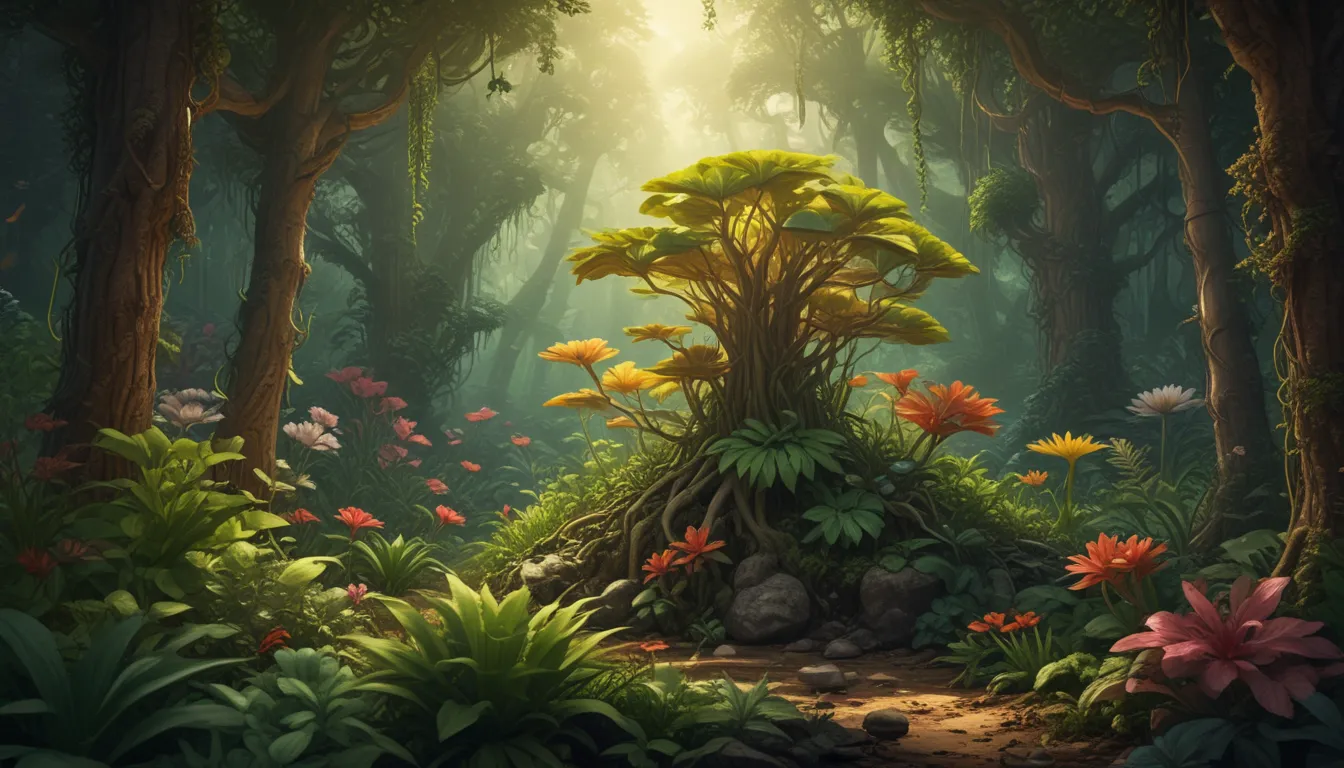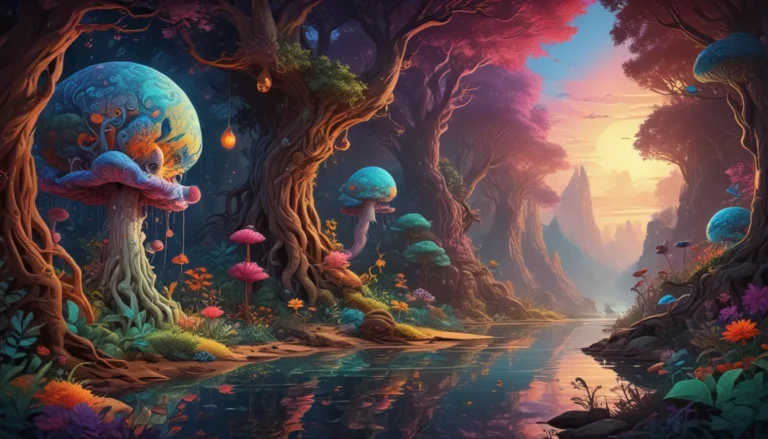A Note About Images: The images used in our articles are for illustration purposes only and may not exactly match the content. They are meant to engage readers, but the text should be relied upon for accurate information.
Plants, the unsung heroes of the natural world, play a crucial role in sustaining life on Earth. From the towering giants of the forest to the delicate blossoms in meadows, the plant kingdom, or Plantae, is a diverse and captivating group of organisms that never fails to astound us with their unique adaptations and resilience. Join us on an enchanting journey as we uncover 19 amazing fun facts about plants, delving into their extraordinary abilities, remarkable characteristics, and surprising relationships with the environment and human society. Get ready to be amazed by the wonders of the botanical realm as we explore the fascinating world of plants together.
The Marvels of Plant Diversity
The Largest Flower on Earth: Rafflesia Arnoldii
The Rafflesia Arnoldii, also known as the “corpse flower,” holds the title for being the largest flower globally. This extraordinary plant can grow up to three feet in diameter and is famous for its unpleasant odor, likened to that of decaying flesh. Despite its smell, the Rafflesia Arnoldii stands as a magnificent marvel of the plant kingdom, showcasing nature’s incredible diversity.
The Tallest Tree in the World: Hyperion
Hyperion, a coast redwood located in California, stands tall as the world’s tallest tree, reaching an impressive height of over 379 feet. Its towering presence serves as a testament to the awe-inspiring grandeur of the natural world, reminding us of the majestic beauty that plants bring to our environment.
The World’s Smallest Tree: Dwarf Willow
On the other end of the size spectrum, the world’s smallest tree, the dwarf willow, also known as Salix herbacea, stands only a few inches in height when mature. Despite its tiny stature, this resilient tree thrives in harsh alpine environments, showcasing the remarkable adaptability of plant life.
Intriguing Plant Adaptations
Carnivorous Plants: Venus Flytrap and Pitcher Plant
Plants like the Venus flytrap and pitcher plant have fascinating carnivorous abilities, luring unsuspecting insects with sweet nectar before trapping them for nutrient intake. These unique adaptations showcase the diverse strategies plants employ for survival, highlighting the ingenuity of nature.
Water-Storage Abilities: Baobab Tree
The baobab tree, known as the “tree of life,” can store thousands of liters of water within its trunk, enabling it to endure harsh drought conditions. This remarkable adaptation not only sustains the tree but also provides a vital water source for wildlife and human populations in arid regions.
Sensitivity to Touch: Sensitive Plant
The sensitive plant, Mimosa pudica, exhibits a remarkable response to touch, with its leaves folding inward upon contact. This intriguing behavior has captivated observers for centuries, showcasing the unique adaptive mechanisms present in the plant kingdom.
Plant-Based Delights
Cocoa Tree and Chocolate Production
The cocoa tree, Theobroma cacao, is the source of one of the world’s most beloved treats: chocolate. Its fruit yields cocoa beans, the fundamental ingredient for crafting delectable chocolate products that delight taste buds worldwide.
Largest Seed: Coco de Mer Palm
The coco de mer palm, native to the Seychelles, produces the largest seed in the plant kingdom, often referred to as “double coconuts.” These colossal seeds can weigh up to 30 kilograms, captivating enthusiasts with their remarkable size and appearance.
Nature’s Spectacles
The World’s Tallest Flower: Titan Arum
The Titan arum, also known as the “corpse flower,” stands as the world’s tallest flower, reaching heights of over 10 feet. Its impressive size and distinctive bloom captivate observers, showcasing the extraordinary diversity and beauty found within the plant kingdom.
Rainbow Eucalyptus Tree
The rainbow eucalyptus tree, native to the Philippines and Indonesia, dazzles with its vibrant display of colors on its bark, featuring hues of green, blue, purple, orange, and maroon. This stunning natural phenomenon offers a captivating glimpse into the remarkable diversity and visual splendor of plant life.
Testaments to Longevity
Oldest Living Organism: Quaking Aspen Trees
A grove of quaking aspen trees in Utah holds the title of the world’s oldest living organism, estimated to be over 80,000 years old. This interconnected root system, or “clonal colony,” thrives and expands, showcasing the enduring resilience of plant life.
Methuselah: The Oldest Known Living Tree
Methuselah, a bristlecone pine located in California, is the world’s oldest known living tree, with an estimated age of over 4,800 years. This ancient and resilient tree stands as a testament to the enduring longevity of plant life.
Plant Pollination Strategies
Corpse Flower
The corpse flower, Amorphophallus titanum, emits a putrid odor to attract pollinators such as carrion beetles and flies. This remarkable adaptation demonstrates the intricate relationships between plants and pollinators in the natural world.
Pitcher Plant
The pitcher plant, characterized by its distinctive pitcher-shaped leaves, traps insects to supplement its nutrient intake. This fascinating adaptation highlights the diverse strategies employed by plants for survival, showcasing the ingenuity of nature.
Conclusion: Celebrating the Plant Kingdom
In conclusion, the plant kingdom is a mesmerizing realm filled with wonder, diversity, and resilience. Plants not only sustain life on Earth but also inspire us with their remarkable adaptability and unique characteristics. By exploring and appreciating the incredible world of plants, we can cultivate a deeper connection to nature and a greater understanding of our interconnectedness with all living things.
FAQs
What are some examples of unique plant adaptations?
Plants have evolved a variety of remarkable adaptations to thrive in diverse environments. Examples include water-storing capabilities in succulents, aerial roots of epiphytes, and sensitive leaf movements like those of the Mimosa pudica.
How do plants contribute to the environment?
Plants play a crucial role in the environment by producing oxygen, stabilizing soil, providing habitats for wildlife, and serving as a source of food and medicine for humans and other organisms. Additionally, they help regulate the global climate by absorbing carbon dioxide from the atmosphere.
Thank You for Exploring the Wonders of the Plant Kingdom with Us
Our commitment to delivering engaging and trustworthy content drives us to share the fascinating world of plants with you. Each fact presented here is contributed by real users like you, ensuring a wealth of diverse insights and information. Our dedicated editors rigorously review each submission to uphold the highest standards of accuracy and credibility, guaranteeing that the facts we share are not only captivating but also reliable. Trust in our dedication to quality and authenticity as you continue to explore and learn with us.






